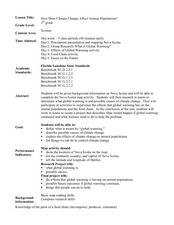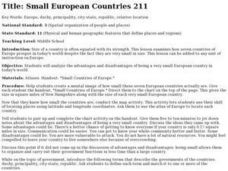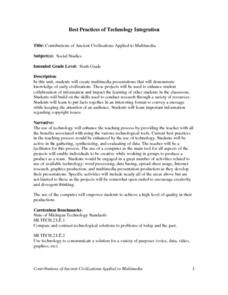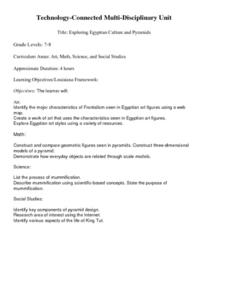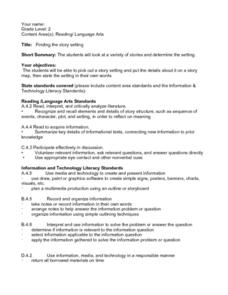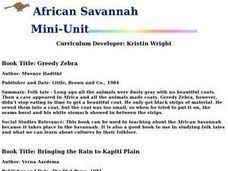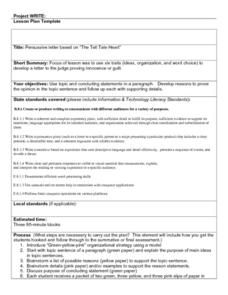Curated OER
Oh Canada!!
Fifth graders become familiar with the people, culture, government and geography of Canada. In this Canadian people and places lesson plan, 5th graders research and create a map of Canada reflecting their gathered...
Curated OER
Straberry Girl: Florida's Location and Shape
Learners explore geography by reading a story about Florida. In this Florida vegetation lesson, students read the book Strawberry Girl and identify the locations in Florida that are mentioned in the book. Learners identify the type of...
Curated OER
How Does Climate Change Affect Animal Populations?
Students investigate the effect of climate change on animal population in Nova Scotia. In this environmental science lesson, students complete a Nova Scotia map activity and research the causes of global warming in small groups. Students...
Curated OER
Cooperative Classroom Text Features Activities
Fifth graders examine text features and create a PowerPoint presentation. In this text features lesson, 5th graders go over Kagan Cooperative Learning Structures and text features before they choose one to include in a book and...
Curated OER
Order, Order
Third graders practice creative writing by making a book. In this book publishing lesson, 3rd graders investigate the steps needed to publish anything by researching the Internet. Students collaborate on a list of 5 steps to...
Curated OER
Small European Countries
Learners examine the advantages and disadvantages of being a very small European country in today's world. They locate each country on a map using the coordinates, discuss the governments of each country, and develop a list of...
Curated OER
Contributions of Ancient Civilizations Applied to Multimedia
Sixth graders complete a long-term unit on ancient and early civilizations. They conduct Internet research, define key vocabulary terms, analyze maps, and create a PowerPoint presentation about a selected early civilization.
Curated OER
On the Road Again
Students examine migration patterns in Africa and China. They watch excerpts from a documentary, define key vocabulary words, complete various student organizers, and create a poster.
Curated OER
Exploring Egyptian Culture and Pyramids
Students access a variety of Egyptian Culture and pyramid related resources on the Internet. They explore various websites, read articles, create an Egyptian art figure, construct a model of a pyramid, and describe the mummification...
Curated OER
Zoo Poo
Learners use Internet research to determine the amount of carbon dioxide produced per unit energy for biomass and coal. For this alternative energy lesson, students research to find out how much energy and carbon dioxide several coal and...
Curated OER
Scenario challenge
Fifth graders become familiar with the geography of New Hampshire and the importance of specific sites in history. In this New Hampshire lesson, 5th graders create a brochure including points of interest and showing distances...
Curated OER
Introduction to the Reformation
Ninth graders investigate the Protestant Reformation. In this global history lesson, 9th graders examine the provided primary sources that enable students to create posters and presentations that reveal how Catholicism, Lutheranism,...
Curated OER
Michigan- Made Products
Students participate in studying about different Michigan-Made Products. They create a Hyper-Studio presentation that details six products that are made in Michigan. They research three different products in depth.
Curated OER
Weather Watchers
Learners conduct Internet research of their community's weather and compare it to the weather in another location. After conducting research, students become weather reporters by reporting their findings to the class by using a...
Curated OER
The Seed and I
Young scholars examine the patterns and structures of seeds and fruits. Using different types of organisms, they identify the similiarities and differences between them. They create their own seed design and shares it with the class.
Curated OER
Finding the Story Setting
Second graders discuss important things to know when reading stories, identify setting in variety of stories, create story map to record information as they are reading, state setting in their own words, discuss whether they thought...
Curated OER
Australia
First graders are introduced to the country of Australia through books, Internet research, maps and music. They listen to stories, watch videos, decorate cookies and participate in an Australian-themed day of activities.
Curated OER
The Middle Ages
Students read books about the Middle Ages. They discuss characteristics of the Middle Ages. In groups, students construct a castle and draw a map to scale. Pupils create a Venn diagram comparing rules in different countries in the...
Curated OER
Spiral Breeze Catcher
Third graders participate in a creative project in order to investigate how a tornado moves. The use of a spiral catcher is used to model the movement of a tornado. Students also watch "The Wizard of Oz" to create context for the lesson.
Curated OER
History in Pictures
Sixth graders interpret diary entries, letters and read maps to better understand portions of history. They create an oral presentation demonstrating understanding of how cultural characteristics have been communicated through art,...
Curated OER
African Savannah
Students are read two African fairy tales. Using the text, they create a map and key for each region mentioned. They compare and contrast the various communities and discover how geographic features affect how people live.
Curated OER
Persuasive Letters and The Tell Tale Heart
Learners write persuasive letters based on "The Tell Tale Heart." They brainstorm topic sentences, main ideas, and details. They analyze the character and determine if he is innocent or guilty. They create a map listing their reasons to...
Inside Mathematics
Coffee
There are many ways to correlate coffee to life, but in this case a worksheet looks at the price of two different sizes of coffee. It requires interpreting a graph with two unknown variables, in this case the price, and solving for...
Noyce Foundation
Photographs
Scaling needs to be picture perfect. Pupils use proportional reasoning to find the missing dimension of a photo. Class members determine the sizes of paper needed for two configurations of pictures in the short assessment task.


